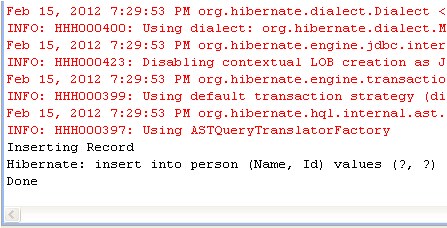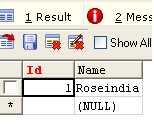First Hibernate Application
In this tutorial you will learn about how to create an application of Hibernate 4.
Here I am giving an example which will demonstrate you how can you make your application using Hibernate 4. To create an application I will use Eclipse IDE ( to see the basic requirement before creating an application with Hibernate 4 click here ).
Example :
Following steps that I have followed to create an application. These are as follows :
Here is the video tutorial of: "First Hibernate Application"
Step 1 : At first I have created a table named person in MySQL.
CREATE TABLE `person` ( `Id` int(10) NOT NULL, `Name` varchar(15) default NULL, PRIMARY KEY (`Id`) ) ENGINE=InnoDB DEFAULT CHARSET=latin1
Step 2 : Created a Java Project named coreHibernateExample (you can give the name as you wish).
File -> New -> project / Java Project -> giveProjectName -> Finish (in this example I have given coreHibernateExample).
Step 3 : Add the Hibernate jar files (to see how to add Hibernate's jar files click here )
Step 4 : Created a package named roseindia (you can give the name as you wish) under the src folder.
Select src -> Right Click ->New -> package -> givePackageName -> Finish (in this exmaple I have given roseindia).
Ste 5 : Created a file by following the name convention hibernate.cfg.xml (mandatory ) file under the src folder that the hibernate utilize to create a connection pool and the required environment setup.
Select src -> Right Click -> New -> File ->hibernate.cfg.xml -> Finish.
<?xml version='1.0' encoding='utf-8'?> <!DOCTYPE hibernate-configuration PUBLIC "-//Hibernate/Hibernate Configuration DTD//EN" "http://www.hibernate.org/dtd/hibernate-configuration-3.0.dtd"> <hibernate-configuration> <session-factory> <property name="hibernate.connection.driver_class">com.mysql.jdbc.Driver</property> <property name="hibernate.connection.url">jdbc:mysql://192.168.10.13:3306/data </property> <property name="hibernate.connection.username">root</property> <property name="hibernate.connection.password">root</property> <property name="hibernate.connection.pool_size">10</property> <property name="show_sql">true</property> <property name="dialect">org.hibernate.dialect.MySQLDialect</property> <property name="hibernate.current_session_context_class">thread</property> </session-factory> </hibernate-configuration>
Step 6 : Created a POJO class (persistent class) named Person.java in the package roseindia.
package roseindia;
public class Person
{
int id;
String name;
public Person()
{
}
public Person(int id, String name) {
super();
this.id = id;
this.name = name;
}
public int getId() {
return id;
}
public void setId(int id) {
this.id = id;
}
public String getName() {
return name;
}
public void setName(String name) {
this.name = name;
}
}
Step 7 : Crated a file named ( you may follow the naming convention ClassName.hbm.xml ) person.hbm.xml under the src folder to map a Person Object to the database table named person
<?xml version='1.0'?> <!DOCTYPE hibernate-mapping PUBLIC "-//Hibernate/Hibernate Mapping DTD 3.0//EN" "http://www.hibernate.org/dtd/hibernate-mapping-3.0.dtd"> <hibernate-mapping package="roseindia"> <class name="Person" table="person"> <id name="id" type="int" column="Id" > <generator class="assigned"/> </id> <property name="name"> <column name="Name" /> </property> </class> </hibernate-mapping>
Step 8 : Developed a code by writing a java class named PersonDetail in the package roseindia which will persist the Person object in the person table.
package roseindia;
import org.hibernate.Session;
import org.hibernate.SessionFactory;
import org.hibernate.Transaction;
import org.hibernate.cfg.Configuration;
import org.hibernate.service.ServiceRegistry;
import org.hibernate.service.ServiceRegistryBuilder;
public class PersonDetail
{
private static SessionFactory sessionFactory;
private static ServiceRegistry serviceRegistry;
public static void main(String[] args)
{
Session session = null;
try
{
try
{
Configuration cfg = new Configuration().addResource(
"person.hbm.xml").configure();
serviceRegistry = new ServiceRegistryBuilder().applySettings(
cfg.getProperties()).buildServiceRegistry();
sessionFactory = cfg.buildSessionFactory(serviceRegistry);
}
catch (Throwable ex)
{
System.err.println("Failed to create sessionFactory object."+ ex);
throw new ExceptionInInitializerError(ex);
}
session = sessionFactory.openSession();
Person person = new Person();
System.out.println("Inserting Record");
Transaction tx = session.beginTransaction();
person.setId(1);
person.setName("Roseindia");
session.save(person);
tx.commit();
System.out.println("Done");
} catch (Exception e) {
System.out.println(e.getMessage());
} finally {
session.close();
}
}
}
Execute the example : You can execute the application as follows
Go to your PersonDetail class Right Click -> Run As -> Java Application or,
Select from the menu bar tab Run -> Run or,
press the Ctrl button along with f11 i.e. CTRL + f11.
Output :
When you will run the application output will be as follows :
1. On console of Eclipse the output will be displayed as :

2. After Successfully execution of the code the record will be saved to the table that you had created in MySQL. as :

